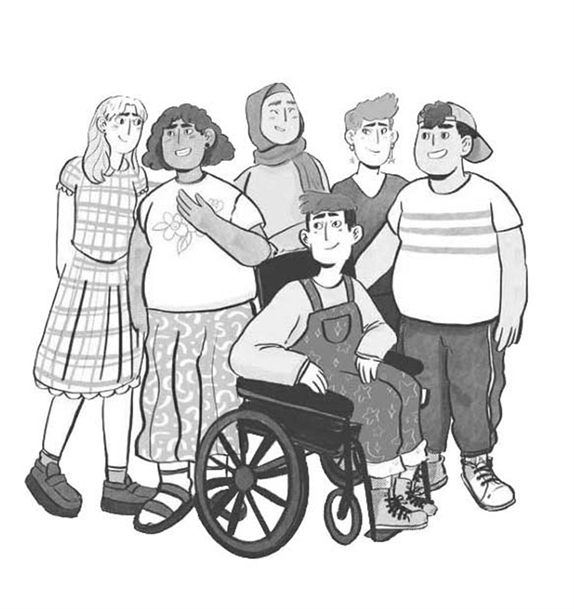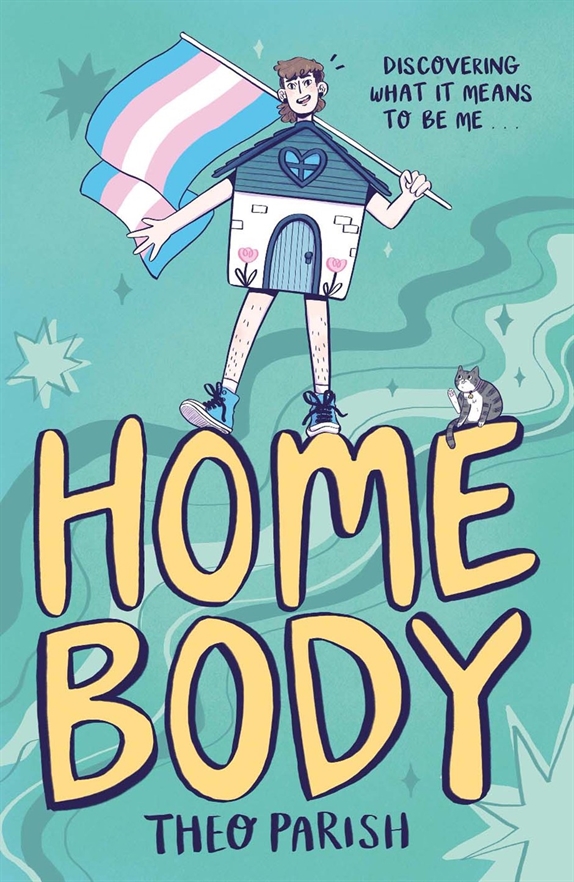
Theo Parish’s Homebody is a celebratory graphic novel that explores what it means to be comfortable with who you are. Beginning life as a poem, Homebody demonstrates that while each person has their own experiences, there is a universality
to life that binds us all together. Here this year’s CILIP Carnegies Shadowers’ Choice Winner for Illustration talks to Jake Hope.
THEO Parish is the author and illustrator of Homebody, a remarkably life-affirming debut graphic novel which explores ideas of identity and the ways society and our sense of self can help to shape this.
Reflecting on the book and their writing and illustration, Theo describes how many of their interests haven’t changed since childhood, saying: “I’ve always been deeply interested in stories, particularly fantasy as an escape from reality.
Many of my interests revolve around storytelling in different forms: dungeons and dragons, video games, films and comic books.”
Theo has been an avid reader since a young age and remembers spending a great deal of time immersed in reading or drawing. Theo’s dad read them The Hobbit and it’s from here that their love of fantasy grew.
“I also read a lot of Terry Pratchett as a child and although I probably didn’t quite understand all the jokes, I absolutely loved the world building and characters. In fact the adaptation of The Colour of Magic may have been the first
proper graphic novel I read.”

Thinking more about graphic novels that have influenced them, Theo recalls Tank Girl, by Alan Martin and illustrated by Jamie Hewlett. “I remember being totally in awe of Hewlett’s dynamic and inimitable style. I’ve always admired artists
whose work you can look at and instantly recognise as theirs and that also instantly communicate a sense of personality or feeling. Those are definitely things I have tried to work towards in my own illustration.”
The sense of feeling which Theo describes is something which comes across incredibly powerfully and poignantly in Homebody. From an early age, Theo always had a sense of their own creativity, revealing: “I think I always wanted to pursue
something creative, but having so many different interests and influences, it took me a while to pinpoint exactly what it would look like.”
Theo’s debut, Homebody, began life as a poem, evolving into a short comic that explored the relationship Theo felt towards their body. This helped form the idea for a central motif for the book which whilst specific and personal to Theo’s
experiences, also has a universality. “The metaphor for the book is the difference between a house and a home and the importance of finding a sense of home in yourself. This metaphor gave me a clear framework for the book as I began
to expand from a short comic to a full graphic novel.”
Discussing its creation, Theo describes how they are “a very visual person so I carried around a sketchbook with me and would scribble down any ideas for images or parts of my experience I wanted to include and then later wrestled all
of these into a storyboard. From this point, I worked digitally inking and colouring the pages.”
Homebody is crafted using a very limited colour palette which contributes to its intimate feel. “I really enjoy working in a limited colour palette, I find that although you are placing more restrictions on yourself that it actually allows
opportunity for thinking creatively within those limitations. I chose to work in pink and blue which are colours of the trans pride flag, for thematic reasons, but also I think they lend themselves well to the tenderness of the content.”
This tenderness is something that feels very special in the book, it’s a high personal story, almost achingly so at points, and yet is one that makes profound comment around who we are and how we might see ourselves. The book relays how
“it has been a bit of a journey to understand and be able to express how I feel about my gender.”
Theo expands upon this, adding: “It’s taken years of self-exploration to understand this aspect of myself, going into the book I definitely had come to terms with and accepted the way I view my gender identity. But writing it down and
putting all of my thoughts onto paper definitely helped me to process it all in a way that felt very cathartic, there are definitely a lot of things in the book that I’ve never said out loud so it did feel very healing to get it out
there.”
It’s hard not to think that some of the ways society is so often structured around binaries limits choices and places a weight of expectation onto everyone. Contemplating this, Theo says: “I think we are moving forwards in general and
starting to, as individuals, examine the way we make assumptions about people based on their gender. But obviously this is a long and involved process because it is so ingrained in us as a society and often, we do these things without
thinking.”
Theo feels that moving from a place where assumptions go unquestioned to a more considered place would be liberating for everyone. “It’s harmful for everyone to have these limitations placed on them based on their gender or expression,
not just LGTBQ+ people, and the more we can begin to examine why we make these assumptions and to start to deconstruct this the better society will be for all of us.”
The choice of the graphic novel form, what Will Eisner called sequential art, art that conveys a definite narrative, is an interesting one Theo has made for the autobiography. It feels as though the form is increasingly now being recognised
for the complexity and weight that its storytelling can bring.
“I have always found it frustrating,” says Theo, “the assumptions that certain types of media or storytelling are somehow inherently more ‘intellectual’ and therefore have more worth. I don’t believe this is true at all, I think we should
embrace storytelling in all forms.”

Sequential art can hold a unique dynamism in how words and illustrations come together to convey meaning and story. Theo discusses this more, highlighting how “comics and graphic novels are special for me because they combine the beauty
of words and images to tell a story in a way that is unique. They can be a much more accessible way for some people to read, not all of us digest information in the same way and reading a sequence of images is just as valuable as reading
a sequence of words.”
Homebody really showcases how the form can convey complex and nuanced ideas. Theo says: “I’m glad it comes across that way, it’s definitely something I really tried to keep in mind while writing. I suppose I just tried to write from a
place of authenticity and honesty, I thought a lot about what I would have wanted to hear at earlier stages of my life and transition.
“I always say that, although it sounds fairly clichéd, I really was writing this book for my teenage self. This is the kind of book that I feel would have made a huge difference to me if I had been able to read it or had it available to
give to the people around me to read.”
Sequential art can have a huge amount to offer to readers and embraces a range of genres and storytelling techniques. “My advice to anyone interested in discovering more would be to try and let go of the assumptions you have about comics
and to read some with an open mind.”
Another excellent way to discover more is at Comic Cons, where there are often many individual and independent creators, making these an ideal place to explore and be excited by the form and the levels of passion and enthusiasm that exists
for it.
There is a really moving description in Homebody about how unifying attending Comic Con was for Theo. Has Theo been to any Comic Cons since the publication of Homebody? The simple answer is “yes”.
Theo says: “I have, and it’s been wonderful to talk to people about the book who have a similar experience to myself and to be able to share that moment with each other.”
What will be next for Theo? “I do have plans for new books! I am currently writing my second YA graphic novel, which is another autobiography but this book will explore my experiences as a neurodivergent person and the process of discovering
and embracing this about myself.”
What does Theo hope young readers take from their books? “I really hope that trans and non-binary readers of Homebody feel seen and understood. I spent a lot of my life feeling alone and unable to communicate what I was going through;
it would have meant a lot to me to hear someone expressing the same sorts of feelings I had so I hope I can do that for others. And I hope that the book conveys the beauty and importance in exploring and embracing what it means to
be you – whatever that looks or feels like.”
There is something both special and profound in that and it perhaps aptly articulates both the profundity and the intimacy of what reading experiences are able to offer – the exploration and embracing of who we are and all that we can
be. Homebody is a deeply affecting read and one which offers hope, opportunity and considerable humanity to its readers. Coming to an understanding that helps us feel at home in our bodies rather than merely housed within them, feels
a worthwhile aspiration for all.”
This interview was first published in CILIP’s Pen&inc. magazine’s Autumn/Winter 2024 issue. Subscribe to Pen&inc.





